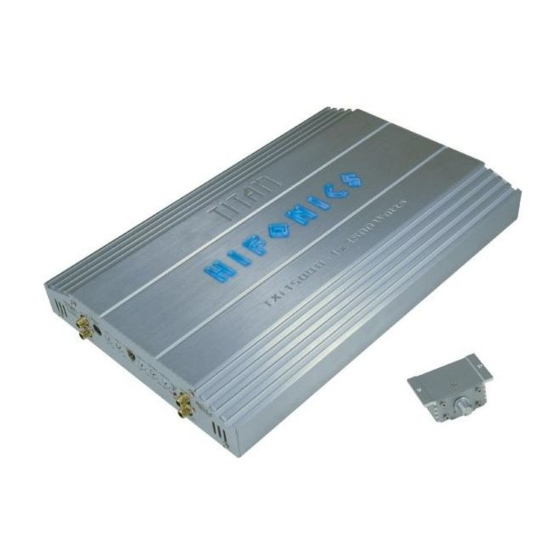Hifonics TXi 1500 D Kullanıcı El Kitabı - Sayfa 11
Amplifikatör Hifonics TXi 1500 D için çevrimiçi göz atın veya pdf Kullanıcı El Kitabı indirin. Hifonics TXi 1500 D 12 sayfaları. Titan series 1-channel mono bass amplifier

System does not turn on
1. Check all fuses.
2. Check all connections.
3. Measure the +12 volt and remote turn on voltages at the amplifier terminals. If these are non existent or low, take voltage measurements at
fuse holders, distribution blocks, the head unit's +12 volt and remote leads to localize the problem.
Noise problems
1.Check the speaker wiring
2.Speakers are damaged
No Signal at all Channels
1. Set Balance and Fader from head unit on Zero-Position
2. Check wiring (Amplifier,Speakers)
3. Speakers are damaged
4. Subsonic Filter is adjusted too high or Lowpass Filter is adjusted too low
Hiss or white noise
1. Speakers are overload
2. High levels of white noise usually occurs when amplifier level controls are turned up too high - readjust according to the procedures in section
"Setting up systems after installation for best performance"
3. Another problem that can cause excessive hiss, is a noisy head unit - unplug the amplifier input RCA cables, and if the hiss level reduces, the
source unit is at fault.
No Stereo-Sound or Low Output
1.Check speaker wiring (- and +)
Amplifier Protection-Mode (red LED is illuminated)
1. Speaker cabels are shorted
2. Inadequate cooling - relocate or remount to provide better natural airflow over the fins.
Driving high power levels into low impedances - back off on the volume control, and/or make sure you are not loading the amplifier with less
than the recommended loudspeaker impedance.
3. Make sure that the battery voltage, as measured at the amplifier's +12 volt and ground terminals, is 11 volts or more.
Electrical interference
The inside of an automobile is a very hostile electrical environment. The multitude of electrical systems, such as the ignition system, alternator, fuel
pumps, air conditioners to mention just a few, create radiated electrical fields, as well as noise on the +12 volt supply and ground. Rememaber to
isolate the problem - first unplug amplifier input RCAcables, if the noise is still present, check the speaker leads, if not, plug the RCA's back, and
investigate the source driving the amplifier, one component at a time.
A ticking or whine that changes with engine RPM:
1. This problem could be caused by radiation pickup of RCA cables too near to a fuel pump or a distributor, for instance, - relocate cables.
2. Check that the head unit ground is connected straight to the vehicle chassis, and does not use factory wiring for ground.
3. Try to supply the head unit with a clean +12 volt supply directly from the battery +, instead of using a supply from the in dash wiring/fusebox.
This type of noise can be more difficult to pinpoint, but is usually caused by some kind of instability, causing oscillations in the system.
A constant whine:
1. Check all connections, especially for good grounds.
2. Make sure that no speaker leads are shorting to exposed metal on the vehicle chassis.
3. RCA cables are notorious for their problematic nature, so check that these are good, in particular the shield connections.
In this amplifier are integrated protection circuits. Short Circuit Protection engaged: The amplifier will turn off and try to come back on
immediately. The amplifier will cycle like this indefinitely, with "blips" of sound each time. If this is the case, check your speakers and wiring for
low impedance and short circuits. Thermal Protection engaged: The amplifier will turn off and several minutes later will come back on. In this
case, ensure that there is nothing blocking the normal convective airflow of the amplifier. No obstruction should be within 2" of the amplifier on
all sides. NOTE: Low battery voltage will cause the amplifier to run warmer and possibly damage the amplifier. If the red LED still lighting up
after all re-checking, the amplfier is damaged. Please send then a detailled malfunction description and a copy of the invoice of purchase
Troubleshooting
Caution!
together with the device to you car audio retailer.
11
18
